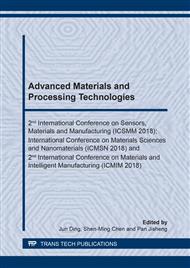p.125
p.129
p.137
p.145
p.151
p.159
p.167
p.175
p.181
Fabrication and Mechanical Property Evaluation of ASD Occluders Made from Shape Memory Alloys
Abstract:
Nowadays, NiTi shape memory alloy plays an important role in medical applications, especially in intervention devices such as Cardiovascular stent, Retriever stent, etc. This research aims to design and fabricate the self-expanding and self-centering Atrial Septal Defect (ASD) closure device from NiTi shape memory alloy wires. The device was made by braiding 72 NiTi wires and forming to double-disk shape. Heat-treatment was carried out at the temperature range between 510°C to 550°C for 30 min, respectively. DSC measurements and pull tests were done in order to evaluate the transformation and mechanical behavior of the devices. The results show that excellent superelasticity can be confirmed in all specimens at room temperature. Recovery forces obtained from pull test increase with increasing heat-treatment temperature. Geometrical control is success with good consistency and the recovery force obtained can be compatible with those of commercial products.
Info:
Periodical:
Pages:
151-155
Citation:
Online since:
July 2019
Authors:
Keywords:
Price:
Сopyright:
© 2019 Trans Tech Publications Ltd. All Rights Reserved
Share:
Citation:


